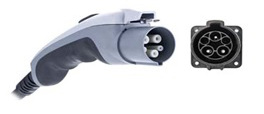Charging Electric Vehicles
Refueling an electric vehicle is different from refueling a conventional internal combustion engine. Electric vehicles need to be plugged into the grid to recharge their batteries. The time it will take to fully recharge a vehicle’s batteries depends on how large the battery pack is, how empty the battery pack is, and what speed it is being charged at. There are currently three speeds or ‘Levels’ that electric vehicles can charge at. Level 1 and Level 2 charging are the most common types used for residential charging at your home or for charging at work. These levels use a special connector known as SAE J1772.
SAE J1772

Level 1
 Level 1 charging is the slowest and is done from a standard 120-volt outlet connected to the vehicle through a cord usually supplied with the vehicle. The connection uses the SAE J1772 connector to supply electricity to the vehicle battery. For PHEVs the time for a full charge can vary between 4 and eight hours, depending on battery capacity. BEVs can take up to 24 hours or more to fully charge using a Level 1 connection. Most PHEV drivers can get a full charge over night using just Level 1 charging.
Level 1 charging is the slowest and is done from a standard 120-volt outlet connected to the vehicle through a cord usually supplied with the vehicle. The connection uses the SAE J1772 connector to supply electricity to the vehicle battery. For PHEVs the time for a full charge can vary between 4 and eight hours, depending on battery capacity. BEVs can take up to 24 hours or more to fully charge using a Level 1 connection. Most PHEV drivers can get a full charge over night using just Level 1 charging.
Level 2
 Level 2 charging uses a 220-volt connection to reduce the charging time of electric vehicles. Customers can purchase special charging equipment called Electric Vehicle Supply Equipment (EVSE) and have them installed at their homes to provide Level 2 charging. Level 2 EVSEs use an SAE J1772 connector to supply electricity to the vehicle battery. PHEVs can be fully charged in as little as 1 ½ hours or up to 4 hours depending on battery capacity. BEVs can be fully charged in 4 to 9 hours using Level 2 depending on battery capacity. Most BEV drivers will need to purchase a Level 2 EVSE to ensure a full charge every night.
Level 2 charging uses a 220-volt connection to reduce the charging time of electric vehicles. Customers can purchase special charging equipment called Electric Vehicle Supply Equipment (EVSE) and have them installed at their homes to provide Level 2 charging. Level 2 EVSEs use an SAE J1772 connector to supply electricity to the vehicle battery. PHEVs can be fully charged in as little as 1 ½ hours or up to 4 hours depending on battery capacity. BEVs can be fully charged in 4 to 9 hours using Level 2 depending on battery capacity. Most BEV drivers will need to purchase a Level 2 EVSE to ensure a full charge every night.
Level 3
 Level 3 charging, also known as DC Fast Charging, uses a special connector to rapidly recharge batteries on BEVs. There are no PHEVs that currently utilize Level 3 charging. There are two connecting standards for Level 3 charging: SAE J1772 Combo Connector and CHAdeMO. Many of the Asian manufacturers have equipped their vehicles with the CHAdeMO charging standard while many U.S. and European manufacturers have adopted the SAE J1772 Combo Connection standard. Level 3 charging can typically recharge a vehicle to 80% capacity in 15 to 20 minutes. Level 3 charging can allow BEVs to travel greater distances than their typical range would allow without needing hours to recharge along the trip. There are a growing number of Level 3 stations being installed in Maryland to help facilitate inter and intra-state traveling.
Level 3 charging, also known as DC Fast Charging, uses a special connector to rapidly recharge batteries on BEVs. There are no PHEVs that currently utilize Level 3 charging. There are two connecting standards for Level 3 charging: SAE J1772 Combo Connector and CHAdeMO. Many of the Asian manufacturers have equipped their vehicles with the CHAdeMO charging standard while many U.S. and European manufacturers have adopted the SAE J1772 Combo Connection standard. Level 3 charging can typically recharge a vehicle to 80% capacity in 15 to 20 minutes. Level 3 charging can allow BEVs to travel greater distances than their typical range would allow without needing hours to recharge along the trip. There are a growing number of Level 3 stations being installed in Maryland to help facilitate inter and intra-state traveling.